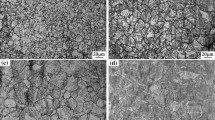Conclusions
-
1.
The optimal chromium content in steel 35GSFB is 2.5–2.9%. A high level of strength, plastic, and ductile properties is provided in the steel with this chromium content after quenching and high tempering in the 630–660°C interval: σu⩾900 N/mm2, σ0,2⩾790 N/mm2, δ5; ⩾ 18%; ψ⩾58% J/cm2; also provided for is a high resistance to brittle and ductile failure:a 1⩾140 J/cm2,a −501 ⩾70 J/cm2,a −500.25 ⩾40 J/cm2, andT 50≤40°C.
-
2.
M3C and M7C3 carbides of globular form, which are uniformly distributed in the matrix of the steel and which exert a favorable influence on its resistance to ductile and brittle failure, are observed in the steel's structure when it contains 2.5–2.9% Cr.
-
3.
An increase in the chromium content to more than 2.9% will effect an increase in the tendency of steel 35GSFB to reversible temper brittleness (ΔT 50≽90°C). Cooling in air or in water after tempering makes it possible to reduce the embrittlement of the steel with 2.5–2.9% of Cr to a level acceptable in practice (ΔT 50⩾30°C).
Similar content being viewed by others
Literature cited
"Basic trends in the economic and social development of the USSR from 1986 through 1990 and during the period to 2000," Materials presented at the Twenty-Seventh Congress of the Communist Party of the Soviet Union [in Russian], Politizdat, Moscow (1986), pp. 267–336.
V. P. Grabovich, Operation and Repair of Turbine Drills [in Russian], Nedra, Moscow (1966).
N. P. Lyakishev, D. A. Litvenenko, Yu. I. Matrosov, et al., "Structural steels of improved strength and cold shortness with microadditives of vigorous carbide-forning elements," Metallurgy: Steels, Alloys, and Processes [in Russian], Metallurgiya, Moscow (1982), pp. 110–116.
O. N. Meshcherinova, V. N. Zikeev, and E. K. Novikova, "On the tendency of structural steels to brittle failure," Strength of Structural Steels and Alloys [in Russian], Moskovskii Dom Nauchno-Tekhnicheskoi Propagandi, (1967), pp. 145–156.
M. M. Sandomirskii, "The specific effect of alloying elements on the softening resistance of steel during tempering," Metalloved. Term. Obrab. Met., No. 7, 10–12 (1981).
Yu. I. Ustinovshchikov, "Causes of the development of brittleness during the high tempering of chromium steels," Fiz. Met. Metalloved.,44, No. 1, 144–151 (1977).
V. A. Korablev, Yu. M. Ustinovshchikov, and I. G. Khatskelevich, "Embrittlement of chromium steels during special-carbide formation," Metalloved. Term. Obrab. Met., No. 1, 16–19 (1975).
Yu. I. Ustinovshchikov, Secondary Hardening of Structural Steels [in Russian], Metallurgiya, Moscow (1982).
Additional information
Translated from Metallovedenie i Termicheskaya Obrabotka Metallov, No. 8, pp. 18–21, August, 1988.
Rights and permissions
About this article
Cite this article
Shukyurov, R.I., Zikeev, V.N., Ismailov, V.A. et al. Effect of chromium on the structure and properties of steel 35GSFB for the shafts of turbine drills. Met Sci Heat Treat 30, 580–584 (1988). https://doi.org/10.1007/BF00778261
Issue Date:
DOI: https://doi.org/10.1007/BF00778261




